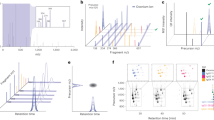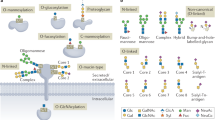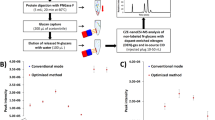Abstract
Purification of protein isoforms for the characterization of post-translational modifications, such as glycosylation, can be laborious and demanding. We report a means of determining monosaccharide composition and the identity of glycoproteins from a single spot on a two-dimensional (2-D) gel. The sensitivity of the method depends on the degree of glycosylation of the protein. We show that bovine fetuin can be analyzed and identified at the level of 100 pmol. 2-D reference maps enable quick identification of glycoprotein isoforms, and the nature of glycosylation differences. Human sera glycoforms were isolated by micropreparative 2-D PAGE using a narrow-range immobilized pH gradient. Single spots excised from one polyvinylidene difluoride blot of a 2-D gel were used sequentially for sialic acid analysis, neutral and amino sugar analysis, and finally amino acid analysis. The glycosylation variations in isoforms of human fetuin and α-1-antitrypsin were determined. The amino acid composition, in conjunction with protein pI and MW, successfully identified the glycoproteins.
This is a preview of subscription content, access via your institution
Access options
Subscribe to this journal
Receive 12 print issues and online access
$209.00 per year
only $17.42 per issue
Buy this article
- Purchase on Springer Link
- Instant access to full article PDF
Prices may be subject to local taxes which are calculated during checkout
Similar content being viewed by others
References
Wasinger, V. C., Cordwell, S. J., Poljak, A., Yan, J. X., Gooley, A. A., Wilkins, M. R., Duncan, M., Harris, R., Williams, K. L. and Humphery-Smith, I. 1995. Progress with gene-product mapping of the Mollicutes: Mycoplasma genitalium . Electrophoresis 16: In press.
Wilkins, M. R., Sanchez, J.-C., Gooley, A. A., Appel, R. D., Humphery-Smith, I., Hochstrasser, D. F. and Williams, K. L. 1995. Progress with proteome projects: why all proteins expressed by a genome should be identified and how to do it. Biotechnology and Genetic Engineering Reviews 13: In press.
Golaz, O., Hughes, G. J., Frutiger, S., Paquet, N., Bairoch, A., Pasquali, C., Sanchez, J. C., Tissot, J. D., Appel, R. D., Walzer, C., Balant, L. and Hochstrasser, D. F. 1993. Plasma and red blood cell protein maps: update 1993. Electrophoresis 14: 1223–1231.
Garrels, J. I., Futcher, B., Kobayashi, R., Latter, I., Schwender, B., Volpe, T., Warner, J. R. and McLaughlin, C. S. 1994. Protein identification for a Saccharvmyces cerevisiae protein database. Electrophoresis 15: 1466–1486.
Latham, K. E., Garrels, J. I., Chang, C. and Solter, D. 1991. Quantitative analysis of protein synthesis in mouse embryos I: extensive re-programming at the one- and two-cell stages. Development 2: 921–932.
Thomas, S. and Singh, R. S. 1992. A comprehensive study of genie variation in natural populations of Drosophila melanogaster. VII. Varying rates of genie divergence as revealed by two-dimensional electrophoresis. Mol. Biol. Evol. 9: 507–525.
Garrels, J. I. 1989. The QUEST system for quantitative analysis of two-dimensional gels. J. Biol. Chem. 264: 5269–5282.
Appel, R. D., Hochstrasser, D. F., Funk, M., Vargas, J. R., Pelligrini, G., Muller, A. F. and Scherrer, J. R. 1991. The MELANIE project: from a biopsy to automatic protein map interpretation by computer. Electrophoresis 12: 722–735.
Ohno, K., Yuasa, I., Akaboshi, S., Itoh, M., Yoshida, K., Ehara, H., Ochiai, Y. and Takeshita, K. 1992. The carbohydrate deficient glycoprotein syndrome in three Japanese children. Brain Dev. 14: 30–35.
Yamishita, K., Ideo, H., Ohkura, T., Fukushima, K., Yuasa, I., Ohno, K. and Takeshita, K. 1993. Sugar chains of serum transferrin from patients with carbohydrate deficient glycoprotein syndrome. Evidence of asparagine N-linked oligosaccharide transfer deficiency. J.Biol.Chem. 268: 5783–5789.
Bjellqvist, B., Sanchez, J.-C., Pasquali, C., Ravier, F., Paquet, N., Frutiger, S., Hughes, G. J. and Hochstrasser, D. F. 1993. Micropreparative 2-D electrophoresis allowing the separation of milligram amounts of proteins. Electrophoresis 14: 1375–1378.
Shaw, G. 1993. Rapid identification of proteins. Proc. Natl. Acad. Sci. USA 90: 5138–5142.
Hobohm, U., Houthaeve, T. and Sander, C. 1994. Amino acid analysis and protein database compositional search as a rapid and inexpensive method to identify proteins. Anal. Biochem. 222: 202–209.
Wilkins, M. R., Pasquali, C., Appel, R. D., Ou, K., Golaz, O., Sanchez, J.-C., Yan, J. X., Gooley, A. A., Hughes, G., Humphrey-Smith, I., Williams, K. L. and Hochstrasser, D. F. 1995. From proteins to proteosones: large scale protein identification by two-dimensional electrophoresis and amino acid analysis. Bio/Technology 14: 61–65.
Ogawa, H., Ueno, M., Uchibori, H., Matsumoto, I. and Seno, N. 1990. Direct carbohydrate analysis of glycoproteins electroblotted onto polyvinylidene difluoride membrane from sodium dodecyl sulfate-polyacrylamide gels. Anal. Biochem. 190: 165–169.
Weitzhandler, M., Kadlecek, D., Avdalovic, N., Forte, J. G., Chow, D. and Townsend, R. R. 1993. Monosaccharide and oligosaccharide analysis of proteins transferred to polyvinylidene fluoride membranes after sodium dodecyl sulfate-polyacrylamide gel electrophoresis. J. Biol. Chem. 268: 5121–5130.
Spiro, R. G. and Bhoyroo, V. D. 1974. Structure of the O-glycosidically linked carbohydrate units of fetuin. J. Biol. Chem. 249: 5704–5717.
Townsend, R. R., Hardy, M. R., Cumming, D. A., Carver, J. P. and Bendiak, B. 1989. Separation of branched sialylated oligosaccharides using high-pH anionexchange chromatography with pulsed amperometric detection. Anal. Biochem. 182: 1–8.
Hayase, T., Rice, K. G., Dziegielewska, K. M., Kuhlenschmidt, M., ReUly, T. and Lee, Y. C. 1992. Comparison of N-glycosides of fetuins from different species and human alpha 2-HS-glycoprotein. Biochemistry 31: 4915–4921.
Fan, J.-Q., Namiki, Y., Matsuoka, K. and Lee, Y. C. 1994. Comparison of acid hydrolytic conditions for Asn-linked oligosaccharides. Anal. Biochem. 219: 375–378.
Devine, P. L. and Warren, J. A. 1990. Glycoprotein detection on immobilon PVDF membrane using the periodic acid/Schiff reagent. BioTechniques 8: 492–495.
Gravel, P., Golaz, O., Walzer, C., Hochstrasser, D. F., Turler, H. and Balant, L. P. 1994. Analysis of glycoproteins separated by two-dimensional gel electrophoresis using lectin blotting revealed by chemiluminescence. Anal. Biochem. 221: 66–71.
Anderseon, D. C., Goochee, C. F., Cooper, G. and Weitzhandler, M. 1994. Monosaccharide anhd oligosaccharide analysis of isoelectric focusing separated and blotted granulocyte colony-stimulating factor glycoforms using high-pH anion-exchange chromatography with pulsed amperometric detection. Glycobiology 4: 459–467.
Riebe, D. and Thorn, W. 1991. Influence of carbohydrate moieties of human serum transferrin on the determination of its molecular mass by polyacrylamide gradient gel electrophoresis and staining with periodic acid-Schiff reagent. Electrophoresis 12: 287–293.
Laemmli, U. K. 1970. Cleavage of structural proteins during the assembly of the head of bacteriophage T4. Nature 227: 680–685.
Jin, Y. and Cerletti, N. 1992. Western blotting of transforming growth factor beta-2: optimisation of the electrophoretic transfer. Appl. Theor. Electrophor. 3: 85–90.
Hochstrasser, A. C., James, R. W., Pometta, D. and Hochstrasser, D. F. 1991. Preparative isoelectrofocusing and high resolution two-dimensional electrophoresis for concentration and purification of proteins. Appl. Theor. Electrophor. 1: 333–337.
Haynes, P. A., Sheumack, D., Greig, L. G., Kibby, J. and Redmond, J. W. 1991. Applications of automated amino acid analysis using 9-fluorenylmethyl chloro-formate. J. Chromatogr. 588: 107–114.
Appel, R. D., Bairoch, A. and Hochstrasser, D. F. 1994. A new generation of information retrieval tools for biologists: the example of the ExPASy WWW server. Trends in Biochem. Sci. 19: 258–260.
Author information
Authors and Affiliations
Rights and permissions
About this article
Cite this article
Packer, N., Wilkins, M., Golaz, O. et al. Characterization of Human Plasma Glycoproteins Separated by Two-Dimensional Gel Electrophoresis. Nat Biotechnol 14, 66–70 (1996). https://doi.org/10.1038/nbt0196-66
Received:
Accepted:
Issue Date:
DOI: https://doi.org/10.1038/nbt0196-66



